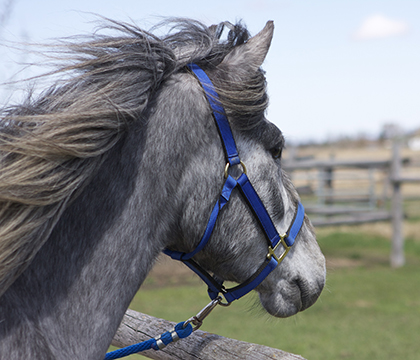
Educational event focuses on EHV-1
The Western College of Veterinary Medicine's (WCVM) Veterinary Medical Centre will host a free, public awareness session to discuss equine herpes virus-1 (EHV-1) from 6 to 8 p.m. on Thursday, Mar. 24.
By WCVM Today
WCVM experts will be on hand to discuss different aspects of the disease and to answer questions.
"We would like to give science-based information to horse owners, trainers and the community," says Dr. Fernando Marqués, an associate professor of large animal medicine and the assistant hospital director at the VMC's Large Animal Clinic.
"Information is one of the first and best tools for prevention."
The free event will be held at the WCVM's Ryan/Dubé Equine Performance Centre on the University of Saskatchewan campus. Click here to register.
A neurological case of EHV-1 was recently confirmed in a stable near Saskatoon, Sask. EHV-1, which is not transmissible to humans, is a common equine virus to which nearly all horses are exposed during their lifetime. EHV-1 usually causes mild respiratory disease, but in some cases, the virus can spread to other parts of the body. In rare cases, the virus can affect the nervous system and cause the neurological form of EHV-1 to develop. It can also cause abortions in pregnant mares.
While EHV-1 is not transmissible to most animal species, the virus is highly contagious among horses and camelids (llamas and alpacas). It's mostly spread by direct contact, as horses come into contact with one another. Indirect contact (sharing contaminated equipment or people moving between horses without adequate hygiene procedures) and aerosol transmission over close distances (when horses cough and form infectious droplets) may also contribute to the virus' spread.
The boarding stable is under voluntary quarantine with the afflicted horse in isolation and receiving supportive care. WCVM clinicians are working closely with the stable to monitor the case as it progresses.
Read more about EHV-1 here.
"We would like to give science-based information to horse owners, trainers and the community," says Dr. Fernando Marqués, an associate professor of large animal medicine and the assistant hospital director at the VMC's Large Animal Clinic.
"Information is one of the first and best tools for prevention."
The free event will be held at the WCVM's Ryan/Dubé Equine Performance Centre on the University of Saskatchewan campus. Click here to register.
A neurological case of EHV-1 was recently confirmed in a stable near Saskatoon, Sask. EHV-1, which is not transmissible to humans, is a common equine virus to which nearly all horses are exposed during their lifetime. EHV-1 usually causes mild respiratory disease, but in some cases, the virus can spread to other parts of the body. In rare cases, the virus can affect the nervous system and cause the neurological form of EHV-1 to develop. It can also cause abortions in pregnant mares.
While EHV-1 is not transmissible to most animal species, the virus is highly contagious among horses and camelids (llamas and alpacas). It's mostly spread by direct contact, as horses come into contact with one another. Indirect contact (sharing contaminated equipment or people moving between horses without adequate hygiene procedures) and aerosol transmission over close distances (when horses cough and form infectious droplets) may also contribute to the virus' spread.
The boarding stable is under voluntary quarantine with the afflicted horse in isolation and receiving supportive care. WCVM clinicians are working closely with the stable to monitor the case as it progresses.
Read more about EHV-1 here.
